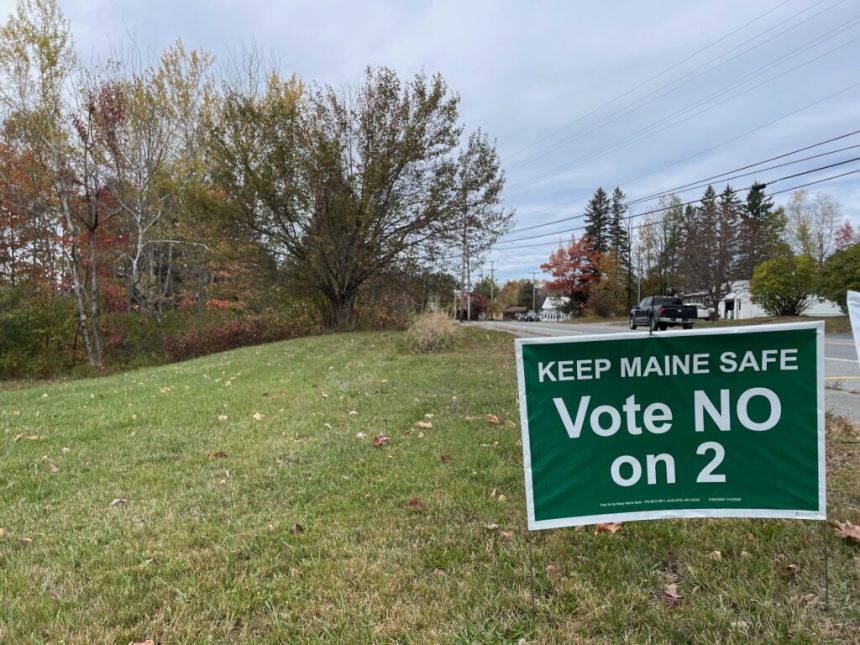A campaign sign against Question 2 on the November 2025 ballot argues that passing a red flag law would make Maine less safe. (Photo by Lauren McCauley/ Maine Morning Star)
If voters approve Question 2 on the November ballot, Maine would end up with two laws on the books that would make it possible to remove firearms from someone considered to be dangerous.
While twenty-one states, including four in New England, have what is known as a red flag law, Maine is the only one that takes a different approach with its so-called yellow flag law. Both are forms of extreme risk protection orders, which are used to temporarily confiscate firearms from someone who poses a risk of danger to themselves or others.
In November, Maine voters will be asked if they want the state to adopt a red flag law. If passed, the law would not replace the existing statute, but rather make both processes available for use in the state.
Gov. Janet Mills recently argued in an op-ed against the referendum that the co-existence of both policies would “create a new, separate and confusing process that will undermine the effectiveness of the law and endanger public safety along with it.”
But proponents see a red flag law as another tool for keeping Mainers safe that could work in concert with the existing policy without stigmatizing mental illness.
Five years into the yellow flag law
Maine’s existing statute allows law enforcement to take guns away from people after a mental health evaluation, whereas red flag laws — like the one proposed in Question 2 — allow family or household members to petition a court directly for someone’s firearms to be temporarily removed.
Since Maine is the only state with a yellow flag law, it would be the only state to see these two laws exist in tandem.
Michael Rocque, a professor of sociology at Bates College, said the potential for confusion lies in the fact that people still don’t know exactly what a yellow flag is.
“If we passed the red flag law, I would imagine that that would sort of supersede the yellow flag law in terms of usage,” he said, arguing the nuance of Maine’s yellow flag law would encourage people to opt for the red flag process that presents as more streamlined.
He pointed to a report from the independent commission that investigated the October 2023 mass shooting in Lewiston that underscored how confusing the yellow flag process was at that time.
In the aftermath of the shooting, some law enforcement officials said the yellow flag law was difficult to use. This testimony was followed up by a finding from the commission that the Sagadahoc County Sheriff’s Office had sufficient probable cause to both take the perpetrator, Robert Card II, into protective custody under Maine’s yellow flag law and start a petition to confiscate his firearms.
While it is still time and resource intensive, Lt. Michael Johnston of the Maine State Police said changes made to the yellow flag law last year, as well as additional training for law enforcement, has made it less cumbersome. And there’s data to back it up.
As of the beginning of this month, the yellow flag law had been used more than 1,100 times. Johnston said 81 of those occurred between 2020, when the law was implemented, and late 2023. More than 1,000 uses occurred in the past two years at a rate of 1.5 per day, he said.
It takes time to adapt to a new law, but it gets smoother and easier to execute with repetition, Johnston said. And now that law enforcement has more familiarity and practice with the current law, Johnston argued that adding a new policy “could potentially detract, undermine or take away resources from a law” that he believes is working well.
Like Mills, he believes having both laws could create confusion, especially for families who may need to navigate these sorts of supports.
“It could potentially muddy the waters when it comes to the relief that families are seeking,” he said. “Do they call law enforcement? Do they try to petition the court? Which process do they follow?”
Should mental health professionals be involved?
Critics have also taken issue with the absence of a mental health element in the red flag proposal, while supporters and industry professionals applaud it for separating violence from mental illness.
Maine Rep. Jennifer Poirier (R-Skowhegan), said mental health is “of the utmost importance here,” and the yellow flag law can connect people with the help and services they may need.
“No person of sound mind is going to want to harm themselves or somebody else… so we need to focus first on the root of the problem and that’s concerning mental health,” she said.
But Jack Sorensen, who does communications for the Maine Gun Safety Coalition and Question 2 campaign, argued that is a misunderstanding of the current law because the stipulated mental health evaluation “is a stamp of approval by a mental health professional that someone should have their firearms removed,” but does nothing to get them actual treatment.
Sorensen also said it’s a misconception that the mental health evaluation in the yellow flag process makes the situation safer because mental health challenges are not a precursor for violence. For this reason, mental health professionals such as the Maine Association of Psychiatric Physicians have voiced their support for Question 2.
“All of us will experience a moment of crisis in our lives at some point. That doesn’t mean we are mentally ill,” Sorsenson said. “So, conflating mental illness with preventable gun deaths is not only misleading, but it’s dangerous. It’s dangerous because it overlooks the reality of a lot of lives that could otherwise be saved.”
But Johnston with the State Police said most of the scenarios that he’s seen the yellow flag law invoked either involve criminal behavior or, more commonly, a mental health crisis involving someone who is suicidal.
“The overwhelming majority of them, they are not bad people, they are going through a difficult time,” Johnston said. “They are human beings that are having a hard time for whatever reason.”
Which one would be faster?
Both those for and against the red flag proposal agree that, in the case of someone posing a threat of danger, they shouldn’t be in possession of a firearm. But there are diverging thoughts as to which policy would contain those situations faster, as well as the value of involving law enforcement from the beginning.
Sorenson and the gun safety coalition say that it’s a good thing communities have had more success with Maine’s yellow flag law in recent years. But, he said, “the fact that it has been used more and more underscores the need for these types of laws and the need for a better, proven, more effective tool.”
He argued that the proposed red flag law would separate a dangerous person from their firearms more quickly and efficiently because families can go directly to a court to file a petition.
Rocque, the Bates professor, argued the two policies could work in tandem. For example, in a case involving a threat of suicide, he said someone could use the red flag process to immediately remove the firearms and then follow up with the yellow flag process to get a mental health professional involved.
But critics question that reasoning since it relies on the availability of the courts and stipulates a 14-day window for a hearing to be held. Johnston pointed out that law enforcement works round the clock, while courthouses could be closed on weekends or have even more limited hours in rural areas.
If someone came to law enforcement on a Saturday with a concern about a family member posing a risk of danger, for example, Johnston said that would require an immediate response. “Would we tell them to go to the court and petition? The answer is no,” Johnston said.
Early police intervention is a key feature for proponents of the yellow flag process.
In her recent op-ed, Mills said the yellow flag “gets law enforcement involved early for good reason.”
Johnston also argued the existing law can better protect law enforcement since they are more aware of potential dangers from the start. Showing up to someone’s house to remove weapons after a red flag process has been initiated could require additional officers or resources, he said, because law enforcement would have less information about the situation.









